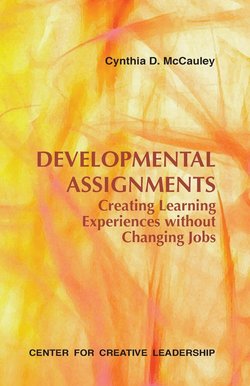Читать книгу Developmental Assignments: Creating Learning Experiences Without Changing Jobs - Cynthia D McCauley - Страница 8
На сайте Литреса книга снята с продажи.
ОглавлениеINTRODUCTION
The purpose of this fieldbook is to help you as a leader more intentionally seek out and design your own developmental assignments (and to help others do the same). It focuses in particular on how to shape your current job and nonwork pursuits so that these activities will provide opportunities to continuously stretch and grow as a leader. We often refer to this approach to learning as development in place because it doesn’t require a major job shift or a move to a new organization. It often does, however, require working with your boss or with others inside or outside the organization to add responsibilities to your job or engage in temporary tasks or roles. We refer to these responsibilities and tasks as assignments. They become developmental assignments when they serve as a source of learning and growth.
This fieldbook is modeled after Eighty-Eight Assignments for Development in Place (Lombardo & Eichinger, 1989), one of CCL’s most popular publications. In the years since that report was published, we have learned more about development in place—from research, from working with managers and organizations who are making use of developmental assignments, and from our colleagues in the field. Our frameworks for describing job challenges and the competencies managers develop from facing those challenges have evolved. Thus, we believe it is time once again to consolidate our knowledge into one tool to help people add developmental assignments to their current jobs.
This fieldbook is organized as follows:
• Background: Chapter 1 provides the rationale for seeking a wide variety of developmental assignments during your career. It provides descriptions from leaders of their own development-in-place experiences. And it defines ten major job challenges that drive on-the-job learning.
• Development in Place: Chapter 2 provides a step-by-step process for choosing a developmental assignment. You will see that there are various options and choices to be made along the way. The chapter concludes with strategies for maximizing learning from assignments.
• Assignments: Chapters 3 and 4 contain tables that are full of examples of development-in-place assignments. The tables will help you target examples that will best fit your learning and development needs. You might find an assignment listed that you hadn’t thought of as an option. And the examples will likely spark additional ideas for assignments—ones that are highly specific to your organization or situation. The tables are by no means exhaustive; they are in-tended to help you generate new possibilities.
• Appendixes: Here you will find resources, a template you can use to create your own developmental assignment plan, and cross-references to CCL’s assessment tools: 360 by Design, Executive Dimensions, Benchmarks, Prospector, and Skillscope. If you want to target the development of specific competencies as a result of receiving feedback from one of CCL’s assessments, these cross-references will direct you to appropriate assignments based on that feedback. The appendix lists the specific competencies for the assessment tool, along with page numbers for related assignments.
